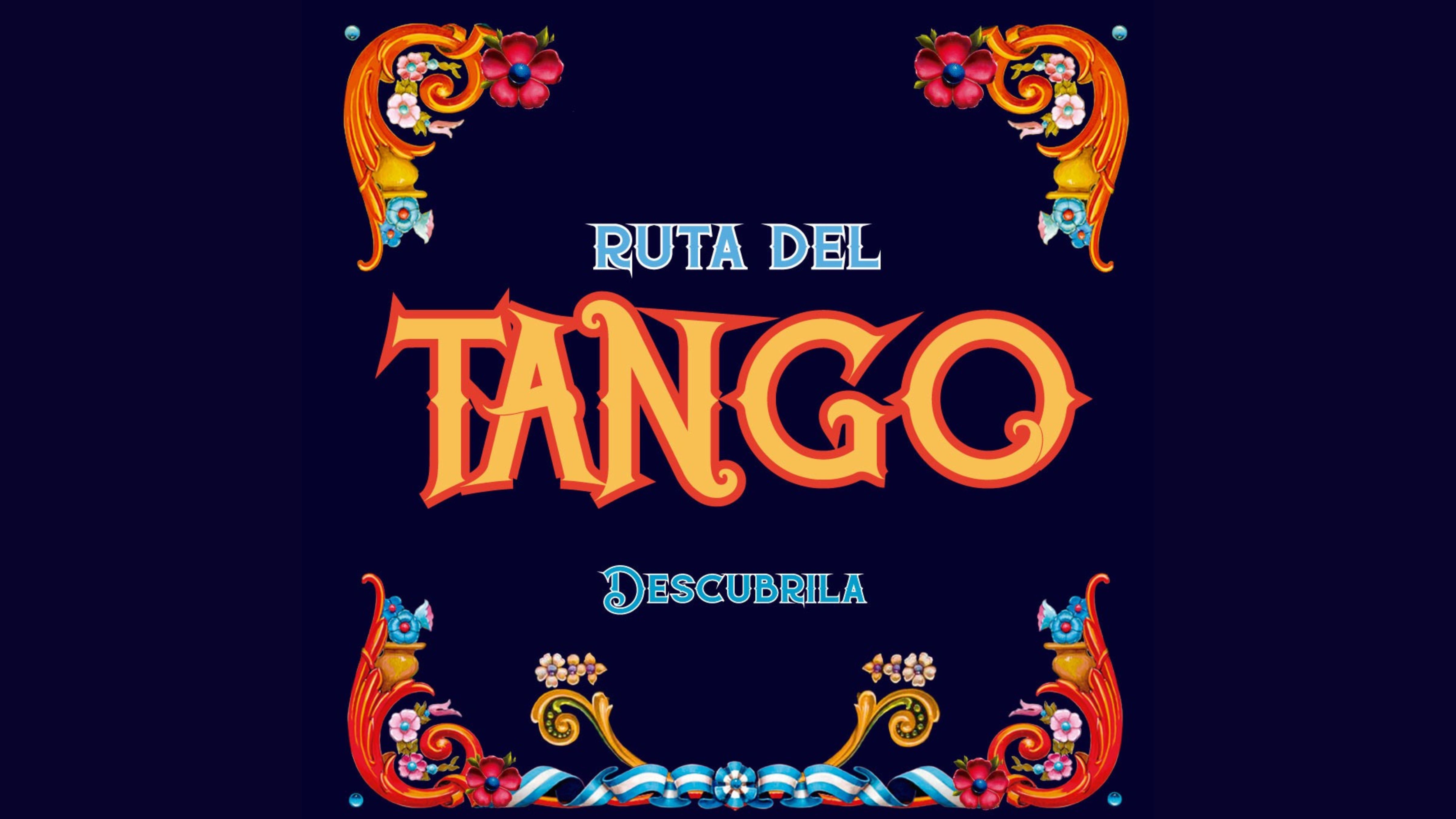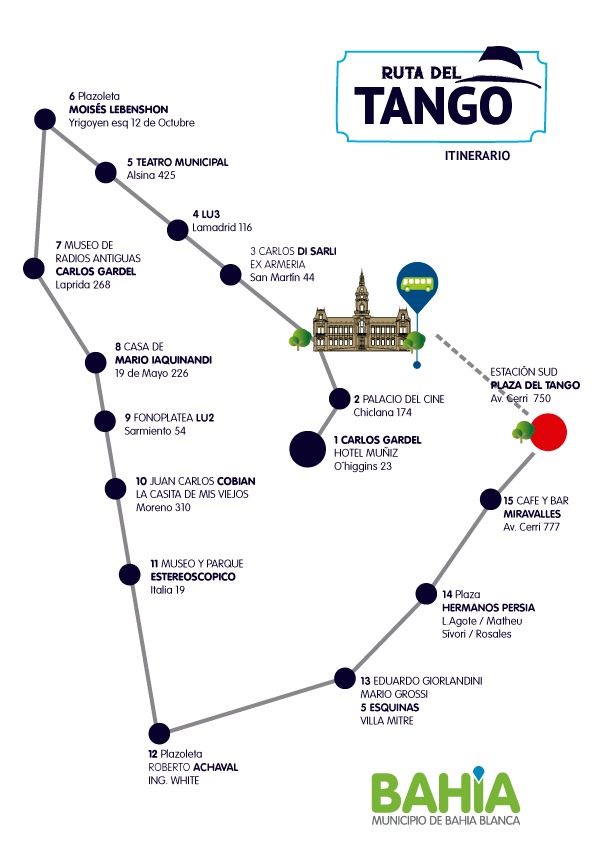
Argentina is recognized worldwide by tango. This musical genre originated along the banks of the “Río de la Plata” river where the working class gathered to entertain themselves. It was included in the UNESCO Intangible Cultural Heritage Lists.
In Bahía Blanca, tango tradition is reflected through well known national and international celebrities, many of whom were locals, while others were welcomed by the city.
We invite you to visit the various points of interest and discover the connection between Bahía Blanca and tango.
“The Route of Tango” is a project created by the Municipal Tourism Department, the expert tango historian José Valle and the School of Visual Arts in 2022.
This work was accomplished thanks to the commitment, support and participation of the following people and institutions:
- Carlos Benítez
- Gabriela Biondo
- Bahía Blanca Bar Association
- Hotel Muñiz
- Cafe Bar Miravalles
- Museo y Parque Estereoscópico
- Leonardo Moreno
- Museo y Archivo Histórico Municipal
- Homero Bimbo
ADDITIONAL REFERENCES
Itinerary

POINTS OF INTEREST
HOTEL MUÑIZ | MUÑIZ HOTEL | 23 O’Higgins St.
This iconic establishment was founded in the early years of the 20th century as “La Central Muñiz”. Its owner was Antonio Muñiz, a Spanish resident who settled in Bahía Blanca in 1895.
Soon after its inauguration, the Hotel Muñiz had the privilege of hosting Carlos Gardel when he performed in the city.
Carlos Gardel, known as “el Morocho del Abasto”, performed 5 times in Bahía Blanca. His first concert was in 1913, and returned to our local stage (Teatro Municipal) in 1918.
In 1924, Gardel performed in “Palace Theatre” (182 Brown St.). Then, in 1930 and 1933 he performed in “Palacio del Cine” (174 Chiclana St.), located a few meters away from the hotel.
Find out interesting facts about Carlos Gardel in the following video:
PALACIO DEL CINE | MOVIE PALACE | 174 Chiclana St.
“Palacio del Cine” was inaugurated in 1928 as a celebration of the city ‘s 100th anniversary.
The building was constructed with the most modern technology of the time following the in vogue Art Decó design by the architect Herminio Manfrin. It was remodeled in 1932 by the Pedro Cabré e Hijos company.
Carlos Gardel, also known as “El Zorzal Criollo”, performed twice in the palace: in 1930 and 1933.
Palacio del Cine closed its doors in 1982 and started to function as a cinema called “Cine Candilejas” up until 1991. Now, its magnificent facade can be admired.
CARLOS DI SARLI | FORMER ARMORY | 44 San Martín St.
Cayetano Di Sarli —known in the tango nights as Carlos— was born in Bahía Blanca on January 7, 1903. He was the son of Miguel Di Sarli, an Italian immigrant, and Serafina Russomano, sister of the renowned tenor “Tito”.
“El Señor del Tango” spent part of his life in the family armory, which was located in this place
We invite you to learn more about his career and path in our city.
LU3 | 116 Lamadrid St.
Radio played a crucial role in the broadcast of music and served as an opportunity to create a bond between the audience and the artist.
The 1930s marked the peak of development for live music broadcasting, prompting many radios to establish their own orchestras and facilities for participating in these performances. In Bahia Blanca, radios such as the traditional LU2 (1930), LU3 (1942), and LU7 (1931), each had their own orchestras, where well-known tango artists showcased their talents.
LU3, an emblematic tango radio station par excellence, featured live shows that served as a stage for numerous artists associated with the musical genre. Since 1959, the radio station has been housed in the residence of the writer Eduardo Marea. Among the writer’s notable works are “Historia de una Pasión Argentina” (1937), “La Bahía del Silencio” (1940), and “Todo Verdor perecerá” (1941).
TEATRO MUNICIPAL | MUNICIPAL THEATER | 425 Alsina St.
Since August 9, 1913, Teatro Municipal has served as the stage for major figures of national and international prestige, many of whom were associated with tango. Therefore, it is essential to recall Carlos Gardel’s performance in 1918 and to emphasize the presence of those who are part of the Tango Route in this city.
PLAZOLETA MOISÉS LEBENSOHN | MOISÉS LEBENSOHN SQUARE
Carlos Di Sarli was born on January 7, 1903. He lived with his parents and siblings at 511 Buenos Aires St., known today as H. Yrigoyen St.
Just a few meters away, in Plazoleta Lebensohn, a bust in homage to his great figure was displayed in 1980.
MUSEO DE RADIOS ANTIGUAS CARLOS GARDEL | CARLOS GARDEL ANTIQUE RADIO MUSEUM | 268 Laprida St.
This museum of antique radios, gramophones, and phonographs belongs to Carlos Benitez, who is passionate about the restoration of old radios and the history of tango in the city. His research has contributed to the understanding of Carlos Gardel’s visits to Bahía.
CASA DE MARIO IAQUINANDI | MARIO IAQUINANDI´S HOUSE | 226 19 de Mayo St.
The history of tango can also be seen through its composers. In Bahía Blanca, when we discuss tango, we refer to Mario Iaquinandi. Born in our city on March 14, 1937, he excelled as a lyricist, songwriter, and tango composer.
FONOPLATEA | LU2 | 54 Sarmiento St.
Numerous singers from various genres, including tango, performed at the Fonoplatea. The initial Fonoplatea was situated at 25 Donado St., within the local radio station called LU2. In 1962, it underwent improvements, transforming into a state-of-the-art acoustic venue with a capacity for 200 people. This space, which served as a connection between the artist and the audience, was situated at 54 Sarmiento Street, where the newspaper La Nueva Provincia operated. Today, this location is home to the Colegio de Abogados of Bahía Blanca (Bar Association).
CASA DE JUAN CARLOS COBIÁN | JUAN CARLOS COBIÁN´S HOUSE | 310 Moreno St.
Juan Carlos Cobián was born in Pigüé in 1896. At the age of 3, he moved to the city of Bahía Blanca with his family. He lived for a significant period in his father’s house, which was an inspiration for him to compose the tango “La Casita de Mis Viejos,” located at 310 Moreno St. Known as the “Chopin del Tango,” he sparked a real revolution by contributing to a new trend that connects classical music with tango.
MUSEO Y PARQUE ESTEREOSCÓPICO EL HISTÓRICO | CAFÉ HISTÓRICO | 19 Italia St.
This museum has thousands of antique objects of all kinds, dating from the time of the foundation of the city up until today. It is important to highlight the commemorative plaque to Alberto Castillo, Aníbal Troilo, Hugo Marozzi and Facundo Cabral who were important figures that made our culture transcend.
Next to the Museum you can find the Café Histórico, a famous place to enjoy tango shows.
ROBERTO ACHAVAL | Ingeniero White
In 1930 Oscar Aníbal Crudelli was born in Ingeniero White, where he lived with his parents at 3350 José Sisco St.
He gained fame due to his participation at “Concurso del Programa Grandes Valores del Tango”, that allowed him to be recognized in his genre, adopting the artistic name “Roberto Achával”.
The city honors him with a monument located at Paseo Portuario and a square inaugurated in 2010, located between Carrega and Guillermo Torres streets. This monument was built to remember him in the History of Tango as the last singer and author of the Anibal Troilo orchestra, a big bandoneon player.
EDUARDO GIORLANDINI AND MARIO GROSSI | Villa Mitre
Entering Villa Mitre is a unique experience. That’s why we would like you to read the lyrics of the tango, written by Eduardo Giolardini (a poet, lyricist, and writer specializing in “lunfardo,” a type of slang) and with music composed by Mario Grossi (a violinist and composer who also specialized in “lunfardo”).
PLAZA HERMANOS PERSIA | HERMANOS PERSIA SQUARE | San Agustín Neighborhood
Tango flourished in the city, due to the significant figures who paved the way for its development. Los Hermanos Persia (The Persia Brothers), Pablo and Pedro, played a crucial role in tango history. Born in 1911, they began their journey in 1927, with Pedro later performing as a soloist and inaugurating LU2 in 1930.
This square is situated in Villa Harding Green’s San Ignacio neighborhood and was established in their honor, recognizing them as important figures in the music history of Bahía Blanca.
CAFÉ-BAR MIRAVALLES | MIRAVALLES COFFEE-BAR | 777 Cerri Ave.
Located across the street from the station Ferrocarril del Sud (train station), Café Miravalles is a family business established by Eustaquio Miravalles in 1923 that was later taken over by his great-grandson. Its decoration is typical from that era, with a style that takes us back in time.
The Café was a place where renowned people from the entertainment world, like Carlos Gardel, gathered. Nowadays a sculpture of him can be found inside the Café next to the table where he drank his coffee in 1933. The sculpture was made by Guido Llordi and restored by Andrés Fortunato.
PLAZA DEL TANGO | TANGO SQUARE | 750 Cerri Ave.
We invite you to discover the importance of this place by going back to its origins…
Plaza del Tango was created by order of Transportation Superintendent, Mr. Arturo Coleman. He decided to establish a green space in Estación Sud to enhance the appearance of the stations along the Ferrocarril Sud line, intending to replicate the aesthetic of stations in England, his homeland.
Initially, Mr. Coleman requested funds from his superiors to hire landscapers, but was turned down. Undeterred, he took matters into his own hands, securing necessary supplies from acquaintances, including seeds, plants, and granite stones for the station’s flower beds. The granite was sourced from Tandil, and the plants were donated by friends. Subsequently, Coleman enlisted the services of a landscaper, who was also added to the growing payroll for lamplighters.
By the spring of 1899, the line stations already boasted well-maintained gardens, marking the inception of an annual contest initiated by Coleman to determine the prettiest garden. Each garden featured meticulously trimmed shrubs spelling out the names of their respective stations, reaching heights of more than two feet.
In 2003, this location was renamed “Plaza del Tango,” providing the city with a place to commemorate the musicians and singers representing the tango genre.
More recent changes and renovations in Plaza del Tango were carried out by professors and students from Bahía Blanca’s Visual Arts School.

